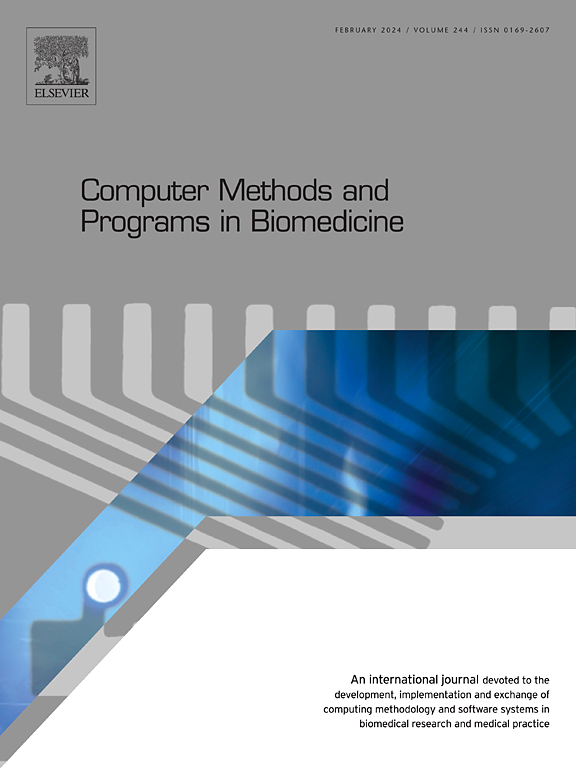FOTELP-VOX-OA:利用粒子输运模拟和优化算法提高放疗计划精度
IF 4.9
2区 医学
Q1 COMPUTER SCIENCE, INTERDISCIPLINARY APPLICATIONS
引用次数: 0
摘要
背景与目的:以最小的健康组织暴露来精确定位肿瘤仍然是放射治疗的重大挑战。像调强放射治疗和立体定向放射治疗这样的现代技术越来越依赖于详细的模拟和计划来实现最大的治疗效率。粒子输运模拟在精确模拟辐射与生物结构之间的相互作用方面起着至关重要的作用,为治疗计划的进步提供了基础。在此基础上,FOTELP-VOX-OA作为一种新的框架被引入,旨在确定最佳的外束放疗治疗计划。本研究的主要目的是将现有的FOTELP-VOX框架与各种优化算法相结合,重点是估计导致最佳辐射剂量的相关参数。虽然框架本身不是病理特异性的,但考虑到肿瘤体积小且靠近关键的眼部结构,眼部黑色素瘤需要非常精确的剂量给药,因此选择眼部黑色素瘤作为试验病例。方法:采用FOTELP-VOX软件进行颗粒输运模拟,进行详细的组织剂量分布分析。模拟条件包括眼部黑色素瘤的详细生物学模型,以密切模仿临床情景。本研究将随机搜索、树状Parzen估计、遗传算法等先进优化算法集成到FOTELP-VOX框架中,创建FOTELP-VOX- oa,实现最优治疗方案。此外,研究人员还开发了一种名为总误差(Total Error)的专门指标,以确定所建议的治疗计划的效率,该指标既关注所需的肿瘤剂量,又关注对周围组织的暴露最小化。结果:在本案例研究中,FOTELP-VOX-OA利用遗传算法实现了总误差为1701.52,与人类专家相比,显著提高了治疗计划。但是,这种方法的计算时间是所有方法中最长的。相比之下,FOTELP-VOX-OA框架中的树结构Parzen Estimator在速度和精度之间提供了平衡的权衡,而基于随机搜索的解决方案是最快的,但也是最不准确的。结论:FOTELP-VOX-OA框架提高了放疗精度,降低了对周围健康组织的风险,取得了较好的治疗效果。这种方法展示了粒子输运模拟,加上优化技术,如何解决放射治疗计划中的关键挑战,为未来在其他肿瘤部位和临床环境中的应用铺平了道路。本文章由计算机程序翻译,如有差异,请以英文原文为准。
FOTELP-VOX-OA: Enhancing radiotherapy planning precision with particle transport simulations and Optimization Algorithms
Background and Objective
: Accurate tumor targeting with minimal exposure to healthy tissue remains a significant challenge in radiotherapy. Modern techniques like Intensity-Modulated Radiation Therapy and stereotactic radiotherapy increasingly rely on detailed simulations and planning to achieve maximum treatment efficiency. Particle transport simulations play a crucial role in accurately modeling interactions between radiation and biological structures, providing a foundation for advancements in treatment planning. Building on this, FOTELP-VOX-OA is introduced as a novel framework designed to determine the optimal external-beam radiotherapy treatment plan. The primary aim of this study is to integrate the existing FOTELP-VOX framework with various Optimization Algorithms, focusing on estimating the parameters of interest that lead to the optimal radiation dose. While the framework itself is not pathology-specific, ocular melanoma is chosen as a test case due to its requirement for exceptionally precise dose delivery, given the small tumor volume and proximity of critical ocular structures.
Methods:
Particle transport simulations were conducted with FOTELP-VOX software, enabling detailed dose distribution analysis in tissues. Simulated conditions included a detailed biological model of eye melanoma to closely mimic clinical scenarios. The study integrates advanced optimization algorithms, such as Random Search, Tree-structured Parzen Estimator, and Genetic Algorithm, into the FOTELP-VOX framework, creating FOTELP-VOX-OA, to achieve the optimal treatment plan. Additionally, a specialized metric named Total Error was developed to determine the efficiency of the proposed treatment plan, focusing on both the desired tumor dose and minimizing exposure to surrounding tissues.
Results:
In the presented case-study, FOTELP-VOX-OA, utilizing the Genetic Algorithm, achieved a Total Error of 1701.52, significantly improving treatment planning compared to a human expert. However, this approach required the longest computation time among all methods. In contrast, the Tree-structured Parzen Estimator within the FOTELP-VOX-OA framework provided a balanced trade-off between speed and accuracy, while the Random Search-based solution was the fastest but also the least accurate.
Conclusion:
The FOTELP-VOX-OA framework improves radiotherapy precision, reduces risks to surrounding healthy tissues, and achieves better treatment outcomes. This approach demonstrates how particle transport simulations, coupled with optimization techniques, can address critical challenges in radiotherapy planning, paving the way for future applications in other tumor sites and clinical contexts.
求助全文
通过发布文献求助,成功后即可免费获取论文全文。
去求助
来源期刊

Computer methods and programs in biomedicine
工程技术-工程:生物医学
CiteScore
12.30
自引率
6.60%
发文量
601
审稿时长
135 days
期刊介绍:
To encourage the development of formal computing methods, and their application in biomedical research and medical practice, by illustration of fundamental principles in biomedical informatics research; to stimulate basic research into application software design; to report the state of research of biomedical information processing projects; to report new computer methodologies applied in biomedical areas; the eventual distribution of demonstrable software to avoid duplication of effort; to provide a forum for discussion and improvement of existing software; to optimize contact between national organizations and regional user groups by promoting an international exchange of information on formal methods, standards and software in biomedicine.
Computer Methods and Programs in Biomedicine covers computing methodology and software systems derived from computing science for implementation in all aspects of biomedical research and medical practice. It is designed to serve: biochemists; biologists; geneticists; immunologists; neuroscientists; pharmacologists; toxicologists; clinicians; epidemiologists; psychiatrists; psychologists; cardiologists; chemists; (radio)physicists; computer scientists; programmers and systems analysts; biomedical, clinical, electrical and other engineers; teachers of medical informatics and users of educational software.
 求助内容:
求助内容: 应助结果提醒方式:
应助结果提醒方式:


